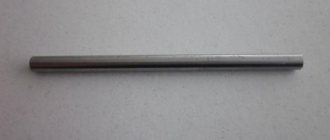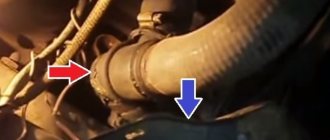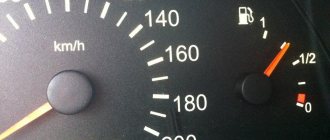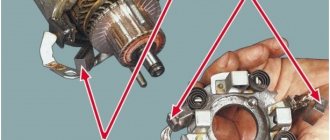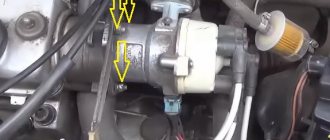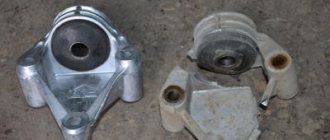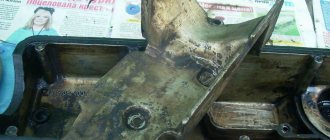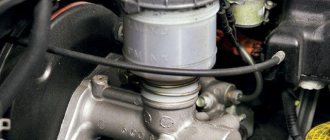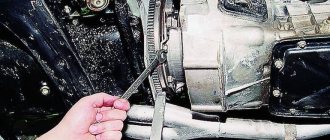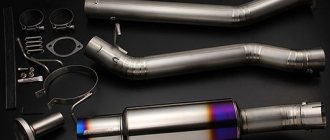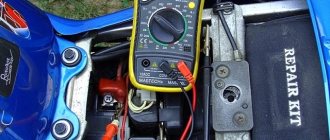A brief history of the disease: the car often sharply reduced speed, twitched, sneezed, and sometimes simply gained momentum poorly. Replaced the spark plugs, adjusted the carburetor, checked the ignition, wires, trombler, and changed the air filter. The fuel pump remained. I just went to buy it, and then the car won’t start anymore! By the time I got out to change it, 2 weeks had passed and the battery was dead. I changed the fuel pump, but I see that the filter is empty (fuel) and both chambers in the carburetor are empty and one is even a little rusty. Those. “pumps” but no gasoline flows. What to do? Tow to service?
The headline is worthy, but seriously, there is too little data on the malfunction. Write in more detail and let's systematize it. 1. Charge the battery. 2. Check the BN as described below. Further - depending on the symptoms.
And “There is such a malfunction - VAZ-2105” - that’s great.
I need a bottle of gasoline. The fuel filter is connected to a metal tube through which gasoline flows from the tank by a rubber hose. You remove it (the hose) from the metal tube and dip it in a bottle of gasoline. There is a manual fuel pump on the fuel pump - you pump it up.
If the force on the lever has dropped, that means everything, the needle valve is closed, you can start it.
If it doesn't wobble, try cranking the engine a little - put it in 4th or 5th gear and push the car a little. then try again.
if the BN still doesn’t pump, remove the hose AFTER the BN and dip it in a bottle of gasoline, lift it higher so that the gasoline flows by gravity into the carburetor.
Let's take it in order > Situation: apparently there is no gasoline flowing into the fuel pump (there is gas in the tank === If this is the case, then disconnect the wire from the pump (the part that goes to the tank) and blow air there. If If there is gurgling in the tank, it means there is leakage. Just in case, check the air tank drainage in the tank. This is a tube that connects the tank with the atmosphere. Maybe water got in there, froze, the pump is trying to pump out gasoline, and Vacc does not work.
> Brief history of the disease: the car often sharply reduced speed, twitched, sneezed, and sometimes simply gained momentum poorly. Replaced the spark plugs, adjusted the carburetor, checked the ignition, wires, trombler, and changed the air filter. The fuel pump remained. I just went to buy it, and then the car won’t start anymore! By the time I got out to change it, 2 weeks had passed and the battery was dead. I changed the fuel pump, but I see that the filter is empty (fuel) and both chambers in the carburetor are empty and one is even a little rusty. Those. “pumps” but no gasoline flows. ===What does it pump if the battery doesn’t turn? With a tongue, by hand? Is there any resistance? The fact is that the engine can settle in such a position that you can’t pump it up with a reed. Turn the CV shaft 1/4-1/2 turn and try to pump it in this position. What about the needle valve? It might be stuck closed. Well, the mesh filter in the carb is not accidentally clogged with some kind of lime. Anything can happen at our gas stations.
> What to do? Tow to service? Yes, it doesn’t seem like that’s a problem. Try checking other points mentioned above. Charge the battery. You can also go to the service if things are getting tight and the frost is still here.
If it is faulty, the fuel supply to the carburetor is completely or partially stopped, which in some cases entails the impossibility of starting both a cold and a hot engine, the engine may also start and stall, and unstable idling is possible.
Checking the fuel pump of VAZ cars
1. Check the serviceability and operation of the entire fuel supply system.
Remove the fuel hose from the fuel pump discharge fitting. Press the manual fuel pump lever several times. If the fuel pump is working properly, a strong stream of fuel should spray out of it. If this does not happen, we carry out a second check.
Checking the serviceability of the fuel system of VAZ cars
2. Check the serviceability of the intake valve.
3. Check the tightness of the exhaust valve.
Place your finger on the hole in the pressure fitting (which is connected to the carburetor) and press the manual pumping lever several times. A stream of air should come out of the fitting hole, which can be easily felt by your finger.
Checking the outlet valve of the DAAZ fuel pump for VAZ 2108, 2109, 21099 cars
Causes of malfunction of fuel pumps of VAZ 2108, 2109, 21099, 2105, 2107 cars
Remove the fuel pump cover. We take out the filter. We clean it, wash it in gasoline, blow it with compressed air. We replace the deformed one.
Fuel purification strainer for DAAZ fuel pump
A sign of their malfunction may be the presence of fuel leaks on the fuel pump body and the smell of gasoline from the engine oil in the engine. The fuel pump stops pumping. Although not necessary. Remove the upper part of the fuel pump housing. We take out the diaphragm assembly. Unscrew the nut on the rod and remove the diaphragms (there are three of them). We replace them with new ones. We assemble everything in reverse order.
Diaphragms (membranes) of the DAAZ fuel pump
Inlet and outlet valves of the fuel pump for VAZ 2108, 2109, 21099 cars
Measuring the amount of protrusion of the fuel pump pusher
We only change the outer thick gasket, which is between the thermal insulating spacer and the fuel pump. Fuel pump repair kits are sold with ready-made gaskets, but you can also cut them yourself from a sheet of paronite.
Gaskets under the fuel pump
The protrusion of the drive pusher beyond the norm of the fuel pump increases its performance, leads to an increase in the fuel level in the float chamber, and this means increased fuel consumption, black spark plugs, difficult starting and a number of other problems that arise when a car engine runs on an over-enriched fuel mixture.
We remove the upper part of the fuel pump housing, the rod with diaphragms and inspect the spring. We replace the broken one.
Fuel pump return spring
One of the most important elements of the fuel injection system of a gasoline engine is the electric fuel pump, which is located in the fuel tank of the car. The fuel pump pumps fuel into the system from the gas tank, creating a certain pressure.
Auto repair experts identify the following common fuel system problems that are related to the fuel pump:
- The fuel pump pumps poorly and does not create the required pressure;
- the fuel pump does not pump when the ignition is turned on;
Considering that the fuel pump is an electromechanical device, the most common fuel pump malfunctions are related to both the mechanical and electrical parts. Next, we will look at what signs indicate a breakdown of the fuel pump and why the fuel pump stops pumping partially or completely.
Fuel pump malfunctions of VAZ 2108, 2109, 21099, 2105, 2107 cars
On VAZ 2108, 2109, 21099, 2105, 2107 cars, fuel pump failure is a fairly common occurrence.
If it is faulty, the fuel supply to the carburetor is completely or partially stopped, which in some cases entails the impossibility of starting both a cold and a hot engine, the engine may also start and stall, and unstable idling is possible. If you suspect that the fuel pump is faulty, you should first check it. Let's look at this procedure using the example of their two most common types - DAAZ and Pekar. They can be installed on both rear-wheel drive and front-wheel drive vehicles.
Checking the fuel pump of VAZ cars
1. Check the serviceability and operation of the entire fuel supply system.
Remove the fuel hose from the fuel pump discharge fitting. Press the manual fuel pump lever several times. If the fuel pump is working properly, a strong stream of fuel should spray out of it. If this does not happen, we carry out a second check.
Checking the serviceability of the fuel system of VAZ cars
2. Check the serviceability of the intake valve.
Remove the fuel hose from the fuel pump suction fitting (we now have both fuel hoses removed from both fittings). We plug it with our finger and press the manual fuel pump lever several times. You should feel a vacuum on your finger (it should be sucked into the fitting). If there is a vacuum, the fuel pump is working; if not, look for a fault in the fuel lines or gas tank.
Vacuum at the suction and discharge fittings of the fuel pump - checking the serviceability of the inlet and outlet valves of the fuel pump
3. Check the tightness of the exhaust valve.
Place your finger on the hole in the pressure fitting (which is connected to the carburetor) and press the manual pumping lever several times. A stream of air should come out of the fitting hole, which can be easily felt by your finger.
Checking the outlet valve of the DAAZ fuel pump for VAZ 2108, 2109, 21099 cars
Causes of malfunction of fuel pumps of VAZ 2108, 2109, 21099, 2105, 2107 cars
— The fuel pump strainer is clogged or deformed
Remove the fuel pump cover. We take out the filter. We clean it, wash it in gasoline, blow it with compressed air. We replace the deformed one.
Fuel purification strainer for DAAZ fuel pump
On the Pekar fuel pump and similar ones, you can remove the filter by unscrewing the suction fitting from the cap. The cover itself does not need to be removed.
— Diaphragms are faulty (thin, cracked)
A sign of their malfunction may be the presence of fuel leaks on the fuel pump body and the smell of gasoline from the engine oil in the engine. The fuel pump stops pumping. Although not necessary. Remove the upper part of the fuel pump housing. We take out the diaphragm assembly. Unscrew the nut on the rod and remove the diaphragms (there are three of them). We replace them with new ones. We assemble everything in reverse order.
Diaphragms (membranes) of the DAAZ fuel pump
There is only one diaphragm on the Pekar fuel pump. You can remove it by removing the cover. To disconnect, turn it 90 degrees.
— Fuel pump valves are faulty
Remove the fuel pump cover and strainer. Visually inspect the cavity of the fuel pump and the inlet valve. Remove the upper part of the housing and inspect the exhaust valve. If the valves are not hermetically pressed into the body, are not pressed tightly, or have lost mobility, the fuel pump must be replaced. If there is a blockage, remove it and blow everything out with compressed air.
Inlet and outlet valves of the fuel pump for VAZ 2108, 2109, 21099 cars
On the Pekar gasoline pump, both valves are located in the cover and their condition can be assessed by removing it from its body.
— The fuel pump pusher is worn out or deformed
Remove the fuel pump from the studs by unscrewing the two nuts securing it. We leave the gaskets, heat-insulating spacer and pusher in the engine. Rotate the crankshaft so that the pusher is recessed as much as possible. We measure the protrusion of the pusher above the plane of the upper gasket. It should be 0.8 - 1.3 mm. If the protrusion does not fit into this size, then we try to adjust it by selecting shims of either thinner or thicker thickness, or by changing the pusher.
Measuring the amount of protrusion of the fuel pump pusher
We only change the outer thick gasket, which is between the thermal insulating spacer and the fuel pump. Fuel pump repair kits are sold with ready-made gaskets, but you can also cut them yourself from a sheet of paronite.
Gaskets under the fuel pump
— The spring under the diaphragms broke
We remove the upper part of the fuel pump housing, the rod with diaphragms and inspect the spring. We replace the broken one.
Fuel pump return spring
A hot engine stalls while driving or idling
Let's start with the fact that the symptoms and signs of this problem can manifest themselves in different ways. Quite often, the power unit may stall in idle mode, and unstable operation and complete stop of the internal combustion engine often occurs after the engine has warmed up.
First of all, diagnostics should begin with checking the spark plugs and their condition. At the same time, high-voltage armored wires should also be checked. This must be done because there may be weak sparking or no spark at all on the spark plug electrodes. Interruptions in the spark lead to serious malfunctions in the operation of the engine, as a result of which both the cold unit and the engine stalls after warming up. Replacing spark plugs and high-voltage wires often helps solve the problem.
Another common situation is when the engine stalls hot or cold immediately after starting it. In this case, on many modern cars with an injection power system, you should check the idle speed sensor. The failure of this element of the electronic engine control system often leads to the fact that the engine is simply unable to operate at idle speed.
In some cases, cleaning the XX regulator helps, in others the device should be replaced. On cars with a carburetor, the idle jets may become clogged and other carburetor malfunctions may occur. Injection engines also require additional checking of the synchronization sensor (DSPS), and possible problems with the fuel pump should not be ruled out. One way or another, if the engine stalls when hot or this constantly happens with a cold unit, then in-depth diagnostics will be required.
On carburetor cars with a mechanical ignition distributor, a situation arises when the slider stops performing its functions. Quite often, after the engine has warmed up, the central wire on the ignition coil may come off, problems with the ignition unit capacitor, etc. may occur. A known problem with cars with a mechanical fuel pump is that the engine stalls in hot weather. This occurs due to overheating, since the high temperature outside and significant heating of the engine compartment do not allow the pump to cool properly.
At the same time, attention should be paid to the condition of the fuel filters. If the filter element becomes clogged, then as the load increases and the speed increases, the required amount of fuel does not flow into the engine through the dirty filter and the engine stalls.
We add that usually before a significant decrease in the filter capacity and a complete stop of the motor, the malfunction progresses. At first, the car may not pick up speed, starts poorly, dips appear when you press the gas pedal, the engine is unstable or jerks when you press the accelerator, in transition modes, etc.
Modern cars with an injector have an electronic control unit (ECU). This unit is quite rare, but still fails. In this case, the engine may stall while driving, and the problem itself manifests itself in various situations, including after the internal combustion engine has warmed up. In this case, as well as if it is necessary to check individual ECM sensors, it is necessary to carry out computer diagnostics of the vehicle. The system will display existing errors in the form of codes, after decoding which it is possible to localize the fault. If the problem is “floating”, that is, it occurs periodically, then it is recommended to purchase a compact device that allows you to read information about engine operation via the OBD connector. Thanks to the subsequent display of data on the screen of a smartphone, tablet or laptop with a pre-installed program, this solution will allow you to record failures in real time.
What is the device
The gasoline pump is a cylindrical barrel measuring 20x15 cm, located under the hood of the car in the carburetor area. It has two tubes, one of them pumps gasoline, and the other supplies it to the carburetor. It also has a lever that is designed for manual pumping of fuel if the mechanical system is not functioning.
The design of the device includes:
- The chamber into which fuel flows from the tank.
- Fuel inlet and outlet valves.
- Diaphragm.
- The ghost lever operates the pumping mechanism.
- Return spring.
- Fist.
- Camshaft
- Sealing gasket.
The operating principle will tell you what each part does.
Operating principle
It works quite simply, just like regular water pumps. In order for the device to begin to function, a mechanical action is applied to it, carried out by the diaphragm. It moves up and down due to the effects of vacuum and pressure. During the downward stroke, a vacuum is created and fuel is sucked into the chamber. When the diaphragm moves upward, it creates pressure and the suction valve closes, and the discharge valve opens, through which fuel flows into the carburetor. The return spring performs the function of causing the movement of the diaphragm.
What are the causes of malfunctions?
The main problem that causes malfunction of the fuel pump of a VAZ-2107 car lies in the sealing gasket. It creates a sealed chamber where the phenomenon of rarefaction and pressure occurs. When this gasket wears out, the seal is broken and not only gasoline, but also air is sucked into the chamber. When the diaphragm moves back, fuel leaks out through a loose seal. Another reason for the pump not to function is clogging of the inlet valve channels. But, this problem was solved by installing a special filter element in front of the gas pump, which extends the service life of the fuel injection device much longer. Rupture of the internal membrane also poses a threat to the performance of the element. If such a problem occurs, it is very difficult to start the engine even when pumping fuel manually.
How to determine the malfunction?
For a VAZ-2107 car, it is easy to find out if the fuel pump is not working. To do this, you need to disconnect the tube from which gasoline enters the carburetor. Next, manual pumping is carried out and if liquid leakage is observed, then the cause of the malfunction is not in the fuel pump. If fuel does not come out of the tube, then the device is faulty, or rather, the problem most likely lies in the inlet valve. You can check this as follows:
- Remove the intake valve tube.
- Close the inlet port with your finger.
- Press the pump lever.
If you feel a vacuum on your finger, then the device is working properly and there is no point in disassembling it.
Fuel pump repair
The device for pumping fuel into the carburetor is subject to repair, unless, of course, the service life of the device is very long. Repair includes disassembling the device, cleaning and replacing worn parts. So, repairs are best carried out with the device removed from its seat, but there are also simple breakdowns that can be repaired without removal. Repairs are carried out in the following sequence:
- The main semicircular cover, which is secured with a bolt, is removed.
- After removing the cover, we carry out a visual inspection. The filter is removed and needs to be washed and blown out for cleaning.
- Further analysis of the device is underway. The six bolts are unscrewed using a screwdriver and the device is separated into two parts.
- The intake and exhaust valves are cleaned. You can wash it in gasoline or solvent and spray it with a stream of dense air.
- To remove the diaphragm, you need to rotate it 90 degrees and carefully remove it.
- Next, we repair the diaphragm, unscrew it and remove all the components.
- Only flexible membranes are damaged, so it is these that need to be replaced.
- When the replacement is made, it is important to assemble the diaphragm in the same sequence as originally.
- The device itself is assembled in the reverse order of removal.
- When installing the filter, it is necessary to ensure that the hole in it is located above the valve.
- By connecting the two parts, a gasket is installed, which can be additionally lubricated with sealant.
Checking the pump's functionality
After this, you should check whether the pump is supplying gasoline. To do this, just unscrew the clamp securing the supply pipe from the fuel pump to the carburetor, lower the end of the pipeline into a container and make sure that the pump pumps. Some fuel pumps have manual pumping, so checking is easy. But there are also pumps that do not have this function. In this case, you will have to check the operation of the unit with the starter (when the crankshaft rotates, the starter also activates the pump). If uniform streams of gasoline come out of the nozzle, in which no air bubbles are visible, then this is an indicator of the serviceability of the gasoline pump, as well as the fuel lines leading to it. And this already narrows the circle of searches, since problems that arise in the area from the tank to the pump are eliminated.
Causes of problems with the fuel pump
There may be several reasons for pump failure. The main reason, and perhaps the most common - there is not enough pressure or the pump is not pushing at all - usually the culprit is a cracked diaphragm. Low pressure symptoms can also be caused by leaking pump valves.
Less common problems include wear on the cam actuated lever, wear on the lever shaft, decreased spring force, clogged pumps due to prolonged failure to clean the sump, and broken sump, which is often glass. Another common problem is that any of the return lines to the fuel tank are clogged when the pump pumps under too much pressure and floods the engine. Damage to housings is very rare, but such defects usually lead to replacement of the entire pump.
First, let's look at the most common problems.
- Gasoline (diesel fuel) has run out. No matter how paradoxical it may sound, drivers often forget to monitor the level of fuel in the tank.
- On diesel engines (especially in winter), the reason that the car started and stalled almost immediately could be frozen fuel (but as a rule, diesel VAZs are very rare).
- The quality of gasoline at gas stations is often appalling, so if you fill your car with low-quality fuel, you may encounter the problem of a stalled engine. If there is only a little bad gasoline, you can dilute it with good gasoline. But if the tank is full, then it’s better to drain the surrogate out of harm’s way.
- Worn wires and old (faulty) spark plugs are also quite often the cause.
- Engine compression, or rather its absence, can provoke a situation in which the engine stalls barely having time to “catch up”. But this is already a very serious breakdown, the appearance of which is accompanied by a host of other symptoms, which are simply impossible not to notice during the operation of the car.
An interesting article about biofuel produced from ordinary sawdust, read more here.
Reasons for lack of submission
The owner of a VAZ 2106 is faced with a choice - which path to take in order to restore the functionality of the pump.
The first option is the simplest and most reliable
, but expensive in terms of cost. Any decent service station has equipment that, in a minimum amount of time, will not only measure the pressure at the inlet and the vacuum at the outlet of the fuel pump, but also identify the part causing defects in the operation of the equipment.
Second
The option is not the simplest, not so fast, but practically free, except for the time spent on it - do all the diagnostic and repair work yourself in the garage.
The process of installing a fuel pump on a VAZ 2107
Now, after dismantling the fuel pump, before installing a new one, you must first check it. If the mileage of your VAZ 2107 car is more than 100 thousand km, then before installation, be sure to check the minimum protrusion of the pusher. Since the location of the fuel pump, as well as the correct stroke of the diaphragm unit of the fuel pump, directly depends on its position. In the case when the stroke of the diaphragm unit is disrupted or its position is incorrect, the fuel injection by the pump is sharply reduced; in other cases, the diaphragm itself may break directly. Changing the protrusion of the pusher on a VAZ 2107 is very simple; to do this, you need to select gaskets of the required height, installed between the spacer and the cylinders.
Let's start installing a new fuel injection pump on a VAZ 2107:
- When you check the amount of protrusion, this must be done with the gasket installed, taking into account its thickness, we are talking about the gasket that is installed between the spacer and the cylinders. Temporarily during the measurement period, you can install two gaskets - between the cylinder block and the spacer, for the purpose of greater accuracy;
- Correctly set the minimum projection by slowly rotating the crankshaft. Press the spacer onto the cylinders and measure how much the pusher protrudes. Its protrusion may fluctuate, but not more than 1.3 millimeters, or not less than 0.8 millimeters;
- In the case when the pusher protrudes more than due, then it is necessary to replace the gasket between the spacer and the cylinders with a new one;
- Well, if the pusher is not visible enough, then for this you need to reduce the thickness of the gasket (less than 0.3 millimeters).
This article described one of the possible problems associated with a malfunction of the VAZ 2107 fuel injection pump. Now, having read this information, you can easily find the location of the fuel pump in your car without unnecessary difficulties and, if necessary, dismantle it and correctly install a new one.
The basis of malfunctions of VAZ carburetors
The first signs of a carburetor malfunction may be the engine turning off immediately after starting or unstable operation at idle speed. The causes of these problems are:
- Clogged fuel nozzle channels XX. To fix this problem, you need to remove the nozzle, disassemble it and blow out the channel from the end with compressed air.
- Malfunction of the EPHH control system or electromagnetic jet (malfunction of the VAZ-2107 carburetor). In this case, you should check the power supply to the valve from the control unit using a test lamp. The performance of the valve itself can be checked using a tester.
- Violation of the tightness of the float mechanism. In this case, the specified fuel level in the chamber is not maintained. As a rule, gasoline overflow occurs. To eliminate the malfunction, you must first replace the needle along with the seat, and then adjust the required fuel level.
- Insufficient clearance at breaker contacts. A sign of this may be unstable speed due to strong sparking of the contacts or a poor-quality spark. To eliminate the malfunction, it is necessary to adjust the contact gap (0.4 mm) and check that there is no play in the bearing.
- Failure of the resistor, which is built into the distributor runner, can lead to poor spark quality. In this case, you will have to replace the resistor. If a breakdown occurs on the way and you need to continue moving, you can temporarily repair the broken circuit with a thin wire, wrapping it around a resistor.
- Wear or large play of bearing 800706U in a distributor with a vacuum corrector can be determined by an unstable spark. The damage can be eliminated by replacing the bearing.
- Air leaks into the intake pipe can be the result of the following problems:
violation of the tightness of the hose or the vacuum brake booster system itself;
- burnout of the head gasket or failure of the pipe connection;
- wear or deformation of the crankcase ventilation system spool, which is located on the axis of the first chamber;
- failure of the drainage tube;
- coking of the annular slot zone of the quantity screw and sprayer.
The car accelerates poorly or with dips
If the engine speed in idling mode is stable, but the car has dips or picks up speed rather slowly, malfunctions of the VAZ-2109 carburetor can be caused by the following problems:
- the fuel level in the float chamber is low;
- insufficient fuel injection due to improper operation of the accelerator pump;
- late ignition;
- sticking of the centrifugal regulator of the ignition system interrupter-distributor;
- the dimensions of the nozzles or air and main fuel jets do not correspond to the specified parameters;
- clogging of the channels of the quality and quantity jets;
- plaque on the emulsion tube of the primary chamber due to water ingress;
- suction in the intake manifold or mismatch of the XX jet, which is typical after installation of a gas installation;
- malfunction of the coil, slider, resistor, spark plugs or broken wire.
How to check the performance of the fuel pump without removing it?
First of all, you need to carefully inspect the fuel pump. Particular attention should be paid to the fit of the cover 4 to the body 3. The skew of the cover, its weak tightening, and an incorrectly installed nylon mesh filter 2, which also serves as a sealing gasket, contribute to the leakage of gasoline in the connector of the cover and the body or in the mating of the cover and the bolt 5 of its fastening.
Fuel may also leak through the outer spacer 1. This occurs when the working diaphragms 8 are damaged. If the screws 7 securing the housing to the bottom cover are loosened, air may leak into the vacuum cavity, and therefore the fuel pump will work intermittently, supplying fuel to the mixture with air.
If you find traces of oil leakage, check first of all that the fuel pump is securely attached to the cylinder block, and then determine the condition of the sealing heat-insulating gaskets. The fact is that oil often leaks in these places when the seal is broken.
Without removing the fuel pump, you can check its functionality. To do this, simply disconnect the fuel line coming from the carburetor and, using the manual pumping lever, check the strength of the fuel supply. Remember that manual pumping is impossible if pusher 1 (Fig. below) is at the top of eccentric 2, and the diaphragm rod is correspondingly in its lowest position.
Fuel pump pusher position
In this case, you need to use the starting handle to turn the engine crankshaft just one revolution. This will allow the eccentric and the rod to take a position in which the manual fuel pumping mechanism will be operational.
A working fuel pump delivers gasoline in a full pulsating stream without noticeable air. To be more confident, you can check the operation of the fuel pump using a mechanical drive by turning the engine crankshaft with the starter. At the same time, you should not be embarrassed by the fact that a stream of gasoline will not appear from the first revolutions.
If you suspect a malfunction of the internal elements of the fuel pump, it is, of course, necessary to remove it, disassemble it and eliminate the defects.
Disassembly and repair of the fuel pump
Before disassembling, it is necessary to thoroughly rinse the fuel pump, for which you can use the gasoline in its cavity. It is best to start disassembly with the top cover 4, screwed with a bolt 5 with an 8 mm socket head. Under the lid there is a nylon mesh filter.
Let us remind you that the deformed cover and the broken filter must be replaced with new ones. Under the strainer in the fuel pump housing you will see a pressed and rolled suction valve 6. There are cases when, due to valve failure, you have to replace the entire fuel pump housing since the valves are not supplied separately as spare parts, and replacing them at home is quite difficult .
To remove the fuel pump housing, you need to unscrew six screws 7 with a screwdriver. Before separating the housing from the bottom cover, try to replace their relative positions. This will come in handy during assembly.
The discharge valve is pressed and rolled on the inside of the removed housing. Wash the housing thoroughly in clean unleaded gasoline.
Remember that even the smallest grains of sand trapped between the valve and the seat disrupt the tightness of the valves, which leads to failure of the fuel pump.
Using a thin screwdriver or a match, you can check the mobility of the valves and the tightness of their fit to the seat under the action of the springs. If you can check the operation of the suction valve again on the assembled fuel pump, then the operation of the discharge valve can only be checked now, with the pump disassembled. When blowing air into the discharge pipe, monitor the behavior of the valve, which should sit in the seat and not allow air to pass through.
To inspect the diaphragm assembly, it is advisable to remove it from the bottom cover of the fuel pump; to do this, simply turn the rod 90°. Together with the diaphragm assembly, the outer and inner spacers 1, as well as the diaphragm spring 9, are removed.
Carefully inspect the working and auxiliary diaphragms. Remember that they should not have scratches, cracks, tears, or local hardening. The presence of one of the listed defects requires replacing the defective part with a new one. It should be remembered that the diaphragm assembly is collapsible. The diaphragms and internal spacer sit on the stem and are tightened with a nut. If the fuel pump suddenly fails along the way and you determine that the cause is a deformed diaphragm, plastic film can be used as a temporary measure.
Make a homemade diaphragm from a piece of film. At the same time, do not throw away damaged diaphragms, but place homemade ones between them. This recommendation should only be used as a last resort, but if you have a spare diaphragm assembly, play it safe and replace the entire assembly.
Other causes of fuel pump breakdowns, defects, malfunctions
There are cases when, in cars with high mileage, the fuel pump does not ensure engine operation at maximum crankshaft speed. The cause in most cases is a weakened diaphragm spring. The normal free length of the spring should be 47 ± 0.5 mm. If the spring is truly weakened, it must be replaced with a new one. A temporary option to eliminate the defect is to stretch the spring by hand and install it in place.
Sometimes the cause of a malfunction of the fuel pump is a violation of the length of the pusher outlet. The fact is that during operation, hardening is formed on the pusher, which naturally changes the length of its exit. This pusher needs to be replaced. If a defect is discovered on the way and there is no new pusher at hand, you can, as a temporary option, remove the hardening and try to adjust the length of the pusher using a set of shims.
At the end of the description of the repair operations performed with the gas pump, car enthusiasts should be reminded of one more type of defect, which occurs quite often. Some fuel pumps work well only before the first disassembly, and after secondary reassembly, despite the absence of visible defects, they stop working altogether or work at half capacity.
If you are unlucky and your car has just such a stubborn fuel pump, connect the body of such a fuel pump to the mating surface of the bottom cover without a diaphragm assembly and you will see the cause of the defect: there will be a gap between the mating surfaces.
Such deformed surfaces must be ground in. The zinc alloy from which the body is made is easy to abrade and the grinding process does not take much time.
That's the case with us. If the car “sneezed” or the engine stopped, the first thing the car owner will do is to go looking for the cause on his own and try to fix it, without any services. It doesn’t matter whether an experienced driver is behind the wheel or a novice – everyone gets under the hood. But the difference in this is significant - the driver, who has driven tens of thousands of kilometers, is familiar with the structure of the car and at least knows where to look for a malfunction.
But beginners in technical terms are usually poorly prepared and often look for a problem where it cannot arise at all. The following material is intended specifically for novice car owners who are just learning the basics of owning a vehicle.
In general, if the car simply stalled on the highway for no apparent reason (the engine stopping was not accompanied by a rumble, grinding sound, etc.), then the reason must be sought in two systems - ignition and power supply, and the latter more often becomes the reason for the power plant stopping. Therefore, if the engine stalls, you should check the power system, but you need to know where to start.
The fuel pump works, but does not pump gasoline, the main causes of failure
One of the most important elements of the fuel injection system of a gasoline engine is the electric fuel pump, which is located in the fuel tank of the car.
The fuel pump pumps fuel into the system from the gas tank, creating a certain pressure. Auto repair experts identify the following common fuel system problems that are related to the fuel pump:
- The fuel pump pumps poorly and does not create the required pressure;
- the fuel pump does not pump when the ignition is turned on;
Considering that the fuel pump is an electromechanical device, the most common fuel pump malfunctions are related to both the mechanical and electrical parts. Next, we will look at what signs indicate a breakdown of the fuel pump and why the fuel pump stops pumping partially or completely.
Not enough air
Often the car starts up well and runs on choke, but as soon as the choke is turned off, the engine stalls. This indicates only one thing - lack of air. Most likely the air jets are clogged. They need to be unscrewed and cleaned. Then check that the car should not stall without suction.
There are an incredible number of reasons for poor performance of car components with similar symptoms, but only a specialist with a set of professional diagnostic tools can figure them out. But if you feel confident in yourself, go for it, VAZ service centers are already waiting for you.
Diagnostics
The very first thing when diagnosing, as noted above, listen when you turn on the ignition to see if there is any noise from the fuel pump. The absence of a characteristic buzzing may indicate that:
- VAZ 2107 fuel pump fuse is faulty;
- relay malfunction;
- open circuit of the fuel pump;
- motor malfunction;
- ECU malfunction.
Below is a simplified connection diagram for a VAZ 2107 injector fuel pump:
You can check the fuel pump on a VAZ 2107 injector simply by checking the voltage at its connection block with a tester. The presence of voltage will indicate a malfunction of the electric motor. Instead of a tester (multimeter), you can use a test lamp to diagnose a malfunction.
In the absence of one, this can be done by disconnecting the connection block for the fuel pump and fuel level control and applying voltage with wires from the battery to the place where the gray wire is connected +12 and to the place where the black wire is connected - minus. A humming pump will indicate a faulty fuse, power circuit or ECU.
Diagnostics and replacement of the electric fuel pump on cars of the Zhiguli family
Checking the protection devices for the electrical circuit of the fuel pump on injection VAZs of the Zhiguli family
If there is a problem with the electrical equipment of the fuel pump circuit, it usually does not turn on at all. Turn on the car's ignition without starting the engine and listen. First, you should hear a click from the relay, and then a characteristic “squeal” emitted by the pump’s electric motor. If you don’t hear anything like this, start diagnosing with the electrical circuit of the device.
The pump circuit is connected to the on-board network via a separate relay, and its protection is provided by a fuse. Both of these devices are located in the vehicle's optional mounting block. You will find it under the glove box. It contains 3 relays and 3 fuses. The fuel pump relay (indicated R2 in the diagram) is located in the middle, and the fuse (F3) is to the left of it. We pull the fuse out of its seat and check it by “ringing” it with a tester. If a malfunction is detected, we replace it, not forgetting to comply with the rating (15 A).
You can check the functionality of the relay by installing a known working device in its place. Instead, replace it with the relay located to the right of the one being diagnosed, which is responsible for the radiator fan circuit. If this option does not suit you, turn on the ignition and measure the voltage between the pink wire going to the relay and the vehicle ground. The device should show 12 V. This means that the device is powered. After this, you need to connect the pink wire with the gray one at the relay terminals. So we will connect the fuel pump directly to the battery. If it works (that same “squealing” sound will be heard), simply replace the relay.
The fuel pump relay is located in the middle (R2), and the fuse is located to the left of it (F3)
Checking the fuel pressure in the system
The main indicator of the operation of a fuel pump is the pressure it creates in the system. If the device turns on, pumps fuel, but the engine runs intermittently, take the time to check the pressure. To do this, you will need a pressure gauge with a measuring range of 5–7, equipped with a gas-resistant hose and a threaded fitting (if there is no special one, you can use a regular tire pressure gauge). The sequence of actions is as follows:
- On the fuel rail we find a fitting closed with a plastic cap. Unscrew the cap and connect the pressure gauge hose to the fitting. If your device is not equipped with a special threaded fitting, the hose can be secured to the “nipple” using a small clamp.
Pressure connection
The pressure in the ramp should be 2.8–3.2 atmospheres
When removing the vacuum hose from the regulator, the pressure should drop by 0.2–0.7 atmospheres
Replacing the fuel pump on injection Zhiguli cars
You can replace the fuel pump either as an assembly (install a new fuel module) or separately (change only the pump). The cost of a new domestically produced module with a fuel level sensor is 2800–3000 rubles. The production pump itself will cost 500 rubles less.
Replacement Tools:
- slotted and Phillips screwdrivers;
- key to 10;
- key to 7.
Work order:
- Disconnect the negative terminal from the battery.
- Open the gas tank cap.
- Using a slotted screwdriver, remove the rubber apron from the neck of the tank. Disconnect the safety valve tube from it.
Use a slotted screwdriver to pry off the apron
Unscrew the screws securing the gas tank trim
Unscrew the tank clamp bolt
Disconnect the electrical wiring, fuel line hoses, unscrew the nuts securing the fuel module cover
Removing the fuel module from the gas tank
Disconnect the fuel filter
Disconnect the pump power cables
Use a screwdriver to move the clamps and remove the pump from the casing.
The fuel pump does not pump..(
- Please log in to reply.
#21 alexdoc
- Users
- 1,965 messages
- Registration 04-March 09
- Top
- Complaint
it doesn’t pump manually or with the starter..( (there is gasoline in the tank).. the filter in front of the fuel pump is empty.. what could be wrong and how can it be fixed
First try to sip gas from the tank with your mouth. If you swallow it, then the problem is only in the pump; if you suck out the air, remove the sensor from the tank and see what’s there. If neither gas nor air flows, then
Fuel line clogged or clogged
#22 Edelweiss75
Message modified: Edelweiss75, 04 October 2013 - 06:48.
- Top
- Complaint
#23 Edelweiss75
- Top
- Complaint
#24 Yurec77
- From: Kyiv
- Auto: 21043/lanos.
- Top
- Complaint
#25 Navstar
- Top
- Complaint
#26 alexdoc
- Top
- Complaint
#27 vavanchik-h
- Top
- Complaint
#28 Visitor
- Top
- Complaint
#29 alexart
- From: Donetsk region
- Car: 2101,1977
Should the foot lift all the way up on its own?
Now she goes down with her finger and goes up quite a bit.
The return spring broke, this happens often.
Immediately after reassembly, I managed to manually pump gasoline a couple of times (you could see it in the filter), but then it stopped pumping again and the foot fell through.
Well, the pump won’t pump, the manual mode is for pumping after inactivity! Then it idles.
Do I need some kind of putty between the pump and the motor or is there just a gasket? when I separated it from the engine, it was not entirely clear what was there.
There are adjusting shims there, thick textolite, it's like heat-insulating, and cardboard, for adjusting the extension of the fuel pump drive rod.
Added after 2 minutes
The pumps on the classics are the same
I didn't thoroughly disassemble the pump.
- Top
- Complaint
#30 Visitor
- Top
- Complaint
#31 USSRMoto
- From: KiyoF
- Car: Subaru Forester SH 2009
The only thing cooler than black bekha is Lada
- Top
- Complaint
#32 Visitor
Visitor, it’s better to try with the car running. In manual mode, it will pump gasoline into the carb and will not pump any further, it seems.
- Top
- Complaint
#33 avtopeca
- Top
- Complaint
#34 BACCARA
Good afternoon! Same problem. In the morning you need to pump it up to start it. After driving, warmed up, turning it off, it won’t start until it cools down. The pump is a plunger pump. Even when it warms up, I give it speed, it chokes as if there is not enough fuel. Please advise. PS. Now I drive a classic.
the simplest thing is the valve.
- Top
- Complaint
#35 Visitor
Good afternoon! Same problem. In the morning you need to pump it up to start it. After driving, warmed up, turning it off, it won’t start until it cools down. The pump is a plunger pump. Even when it warms up, I give it speed, it chokes as if there is not enough fuel. Please advise. PS. Now I drive a classic.
- Top
- Complaint
#36 bars59
But gasoline remains in the float chamber (this is about a hot place).
- Like this: Sergey72
- Top
- Complaint
#37 Sergey72
Is it there? If the pump doesn’t pump up, then the chamber is practically empty. In the literal sense, you’re running on fumes. I'm already a nerd too. I understand everything, but I'm fucked up. The baker, his mother, in the cold pumps it up for beauty, it just warms up and begins to close and stall. I wet a rag with water, put it on top, for about 20 kilometers everything is OK. Today I went through the stock one, changed the valves, membranes, We'll see. In the store, a huckster with an important face says take a new Baker for 250 grams, it’s a plunger. And apparently I’ve never even heard of what a plunger is. What kind of plunger is there? The same valves and membrane, and only one, that is, in the event of a breakthrough, the gasoline will go into crankcase. The design of the valve head is simply changed and there is no tank in the upper part in which a vapor lock supposedly forms and the pump does not pump in the heat.
- Top
- Complaint
#38 ejik401
- From: Snow City
- Car: VAZ 2107 ZNG, Snow beige
Good day to all. I drive on gas, but in cold weather I warm up on gasoline. Once again, when I had to pump up gasoline, since the fuel filter was empty when switching to gas, I was faced with the fact that when pumping, I could hear air being sucked in and when the gasoline picks up, it leaks through the joint on the top cover of the fuel pump. The losses are, of course, small, but it takes quite a long time to pump gasoline and this creates inconvenience. Is there a cure for this gastrointestinal tract infection and how?
- Top
- Complaint
#39 July
- From: Ukraine
- Car: VAZ 2104, VAZ 2101
ejik401 , the gas pump should always be filled with gasoline, regardless of the type of fuel, the valve that closes gasoline should be located after the pump.
Remove the cover from the pump (10 mm wrench); under the cover there is a gasket with a mesh. Check all surfaces for scratches, flash and other irregularities.
- Top
- Complaint
#40 ejik401
- From: Snow City
- Car: VAZ 2107 ZNG, Snow beige
ejik401 , the gas pump should always be filled with gasoline, regardless of the type of fuel, the valve that closes gasoline should be located after the pump.
Remove the cover from the pump (10 mm wrench); under the cover there is a gasket with a mesh. Check all surfaces for scratches, flash and other irregularities.
sorted it out. I shook off the small debris (a couple of grains in total) and collected it. not leaking yet
What is a fuel pump and why is it needed?
So, the first thing I want to talk about is what a fuel pump is and what it is intended for. As you can already understand from the name, the gas pump comes from two words: gasoline and pump, that is, it is a pump that pumps gasoline, everything seems to be clear here, and there is nothing complicated about it. In the fuel system, the fuel pump - if compared with the human body, can be called a heart, since our heart is also a kind of pump or pump that pumps blood, providing the body with everything vital. Life is impossible without a heart (fuel pump), and this also applies to a car with a non-working gas pump. The car turns into a static pile of metal that is incapable of anything.
